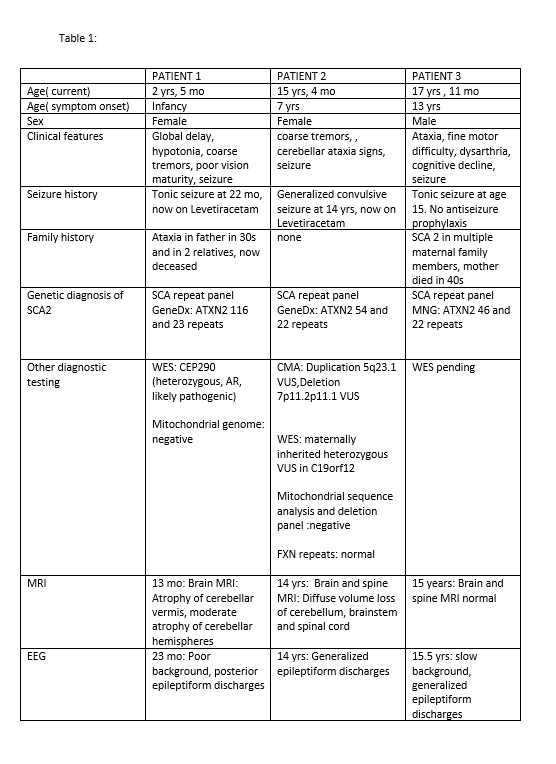Category: Ataxia
Objective: We describe 3 patients of SCA2 with seizures, a rare phenomenology.
Background: Spinocerebellar ataxia (SCA) is a heterogenous group of autosomal dominant neurodegenerative ataxic disorders (1). SCA type 2 is caused by cytosine adenine guanine (CAG) trinucleotide repeats of >=37 in ataxin-2 gene (ATXN2) leading to cell death (2). Clinical features include progressive cerebellar ataxia, cognitive decline, slow eye movements, ophthalmoplegia, Parkinsonism, pyramidal features, and neuropathy (3).
Seizures have been described in other SCA (type 10, 17, 19, ATN1). However, it’s been scarcely reported for SCA2. One large study describes 135 patients with SCA2 of which 2 siblings (one with CAG >180 repeats, other unknown) had infantile spasms. They also summarize 11 case reports of infantile onset SCA2 (most with CAG >200 repeats) with seizures in the literature (4). Of note, cognitive and psychiatric symptoms have been described with SCA type 2.
Method: Retrospective chart review on clinical presentation and diagnostic testing for 3 patients with genetic diagnosis of SCA2.
Results: See table 1.
Patient 1: 2 yrs. 5mo. old: She presented with global delay, hypotonia and coarse tremors since infancy. Patient developed tonic seizures at 22 mo.
Patient 2: 15 yrs. 4 mo. old: She had mild motor delay since toddler years, and progressive action tremor since age 7. She had a convulsive seizure at age 14.
Patient 3: 17 yrs. 11 mo. old: Symptom onset at age 13 with progressive ataxia, fine motor difficulties, dysarthria and cognitive decline. He had single tonic seizure at age 15.
Conclusion: We report seizures as a possible phenotype of SCA2, independent of the number of repeats in ATXN2 or patient’s age. This has not been well documented before although seizures have been reported in other types of SCA. The highest expression of ataxin-2 is in the cerebellar Purkinje cells, large neurons of the substantia nigra, and the trochlear nuclei. However, ataxin-2 is also expressed in glial cells in the cerebral cortex and granule cells in cortical layer II which could explain why some patients have symptoms suggestive of cortical involvement (seizures and cognitive impairment) in addition to ataxia (2). We propose that routine monitoring for seizures should be considered in individuals with SCA2.
Table 1
References: 1. Spinocerebellar ataxia: an update.
Sullivan R, Yau WY, O’Connor E, Houlden H.
J Neurol. 2019 Feb;266(2):533-544. doi: 10.1007/s00415-018-9076-4. Epub 2018 Oct 3.
PMID: 30284037
2. Expansion of the polyQ repeat in ataxin-2 alters its Golgi localization, disrupts the Golgi complex and causes cell death.
Huynh DP, Yang HT, Vakharia H, Nguyen D, Pulst SM.
Hum Mol Genet. 2003 Jul 1;12(13):1485-96. doi: 10.1093/hmg/ddg175.
PMID: 12812977
3. Ataxin-2 gene: a powerful modulator of neurological disorders.
Laffita-Mesa JM, Paucar M, Svenningsson P.
Curr Opin Neurol. 2021 Aug 1;34(4):578-588. doi: 10.1097/WCO.0000000000000959.
PMID: 34010218
4. Genetic profile and clinical characteristics of Chinese patients with spinocerebellar ataxia type 2: A multicenter experience over 10 years.
Yang L, Dong Y, Ma Y, Ni W, Wu ZY.
Eur J Neurol. 2021 Mar;28(3):955-964. doi: 10.1111/ene.14601. Epub 2020 Dec 1.
PMID: 33070405
To cite this abstract in AMA style:
P. Bhatia, S. Kaur. Spinocerebellar ataxia type 2 (SCA2) and Seizures: Is There a Correlation? [abstract]. Mov Disord. 2024; 39 (suppl 1). https://www.mdsabstracts.org/abstract/spinocerebellar-ataxia-type-2-sca2-and-seizures-is-there-a-correlation/. Accessed April 19, 2025.« Back to 2024 International Congress
MDS Abstracts - https://www.mdsabstracts.org/abstract/spinocerebellar-ataxia-type-2-sca2-and-seizures-is-there-a-correlation/

